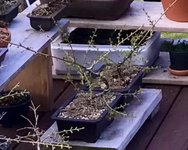Certainly no expert, but I have some experience collecting larch from bog environments. Re
@Dav4 mention above, I follow Nick Lenz guidelines from his book Bonsai from the Wild, and they seem to align with my experience.
If you have the time, I explain Nick's guidance in this video -
Essentially, the top layer of sphagnum decomposes over time, raising the altitude of the bog and creating that 'black death' peat soil. The larch roots die off in that anaerobic soil. The larch sends out adventitious roots as the bog layer rises, into the top-most layer, where there is living sphagnum. So you 1) want to collect only the top most layer of roots that are living and 2) he recommends collecting these in early fall, ideally as the foliage is just starting to color up.
I've gone a few collecting trips for larch - on my spring trip (as noted in the video) the larch did not survive (buds popped and declined). On my fall trips, I have had success. I do protect them over winter from deep freezes but still left them outside protected from wind.
Hope this helps. There are others with much more experience here. Cheers!












